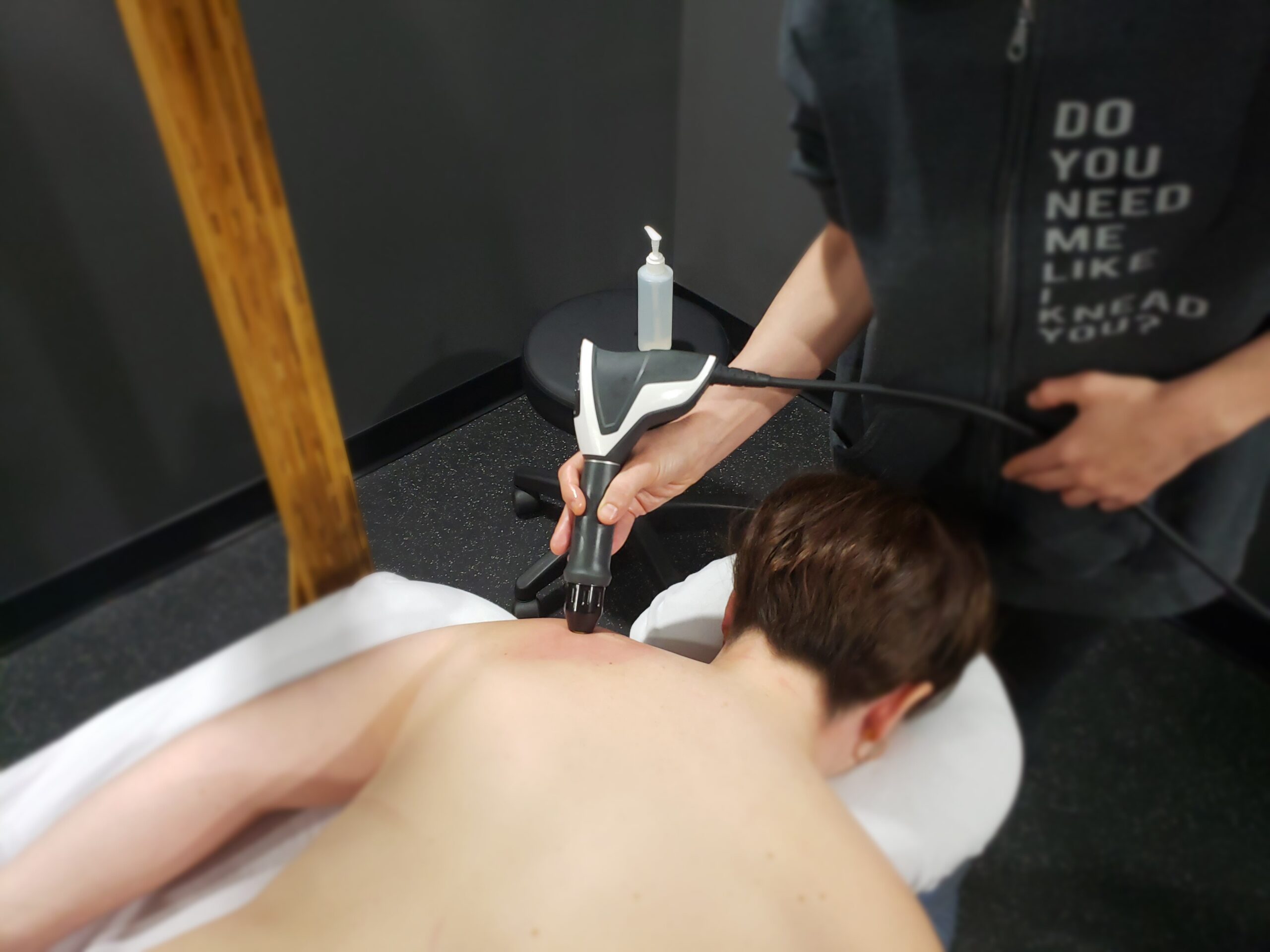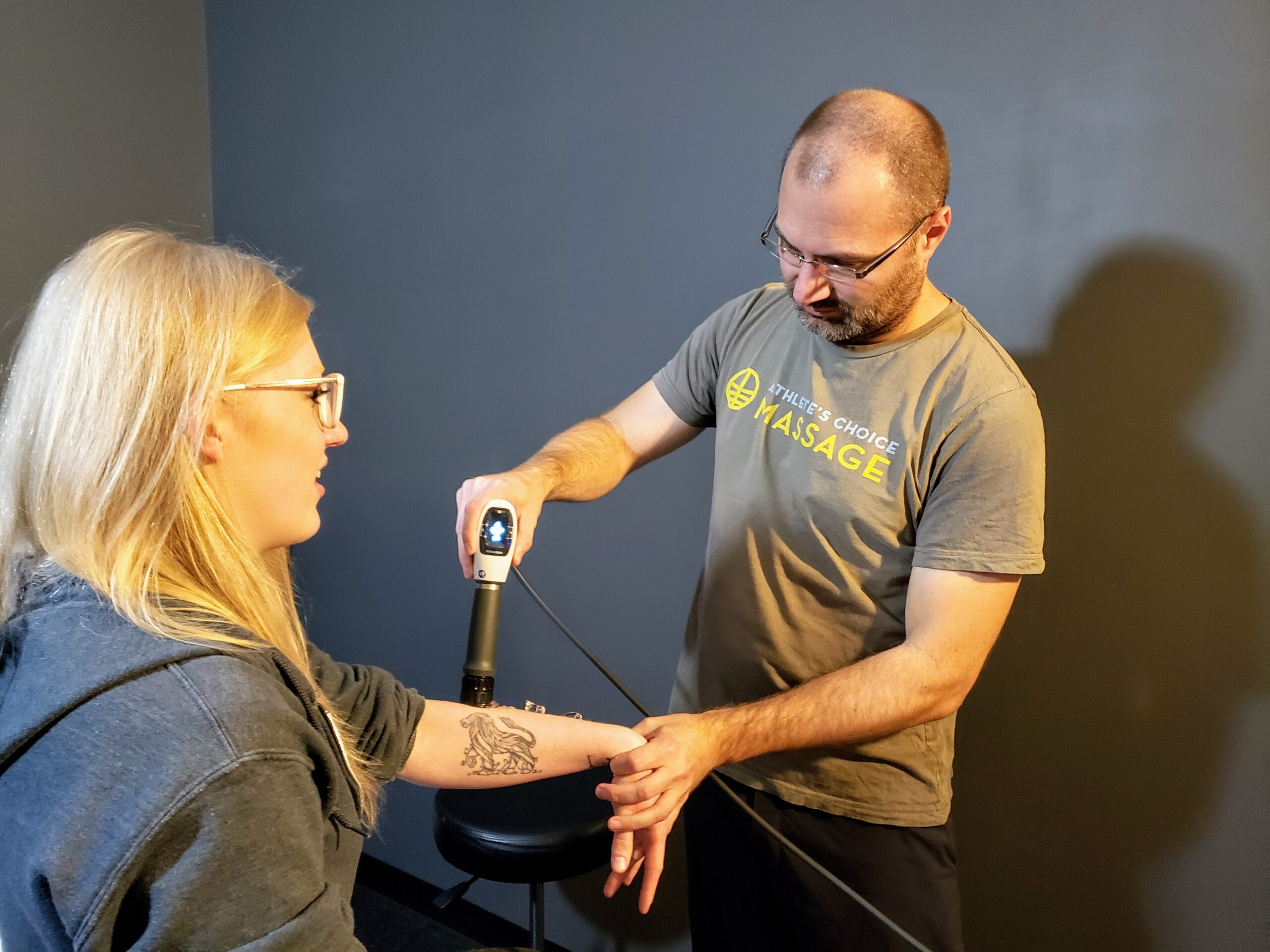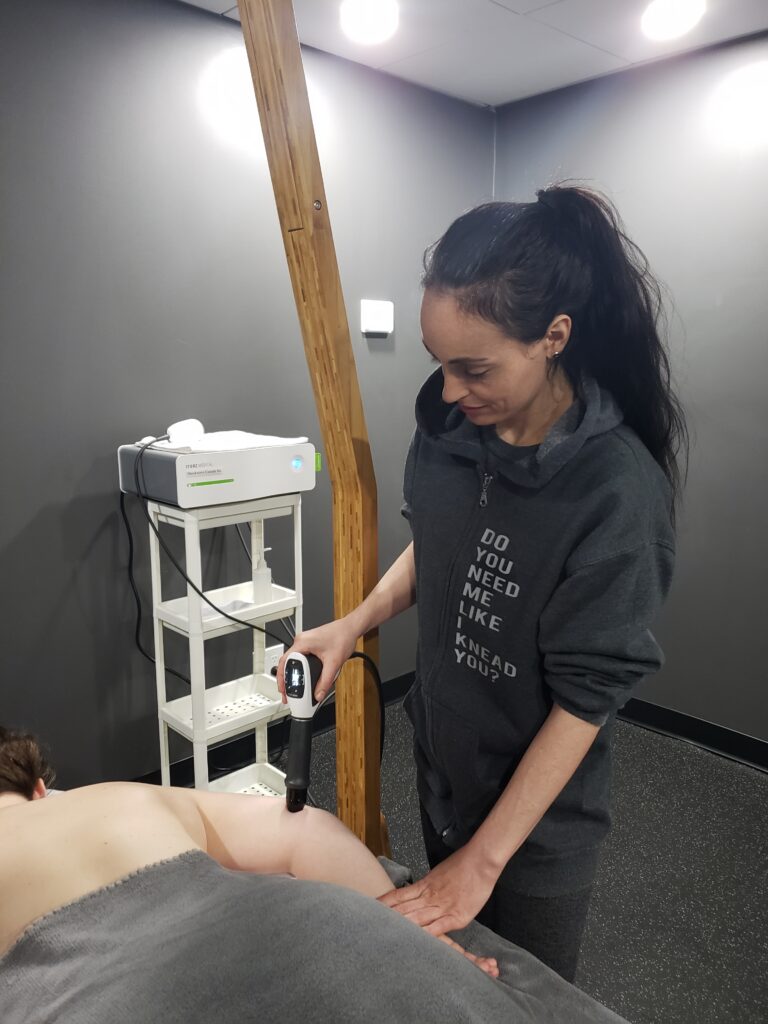Shockwave Therapy Edmonton offers significant benefits for those suffering from trigger points, muscle tension, and various types of joint pain, with SI joint pain being particularly common. This innovative treatment works by addressing the root cause of the problem, which is often deep adhesions and scar tissue that can restrict movement and cause ongoing discomfort. By breaking down these adhesions and promoting tissue healing, shockwave therapy can lead to substantial improvements in both pain levels and range of motion. Many patients experience noticeable relief and enhanced mobility after just a few sessions, making it a highly effective option for long-term pain management and recovery.

30 min | 45 min | 60 min
Direct Billing Available

If you’ve sustained an injury or are dealing with ongoing pain, Shockwave Therapy Edmonton could be the ideal solution for you. This treatment is designed to address various conditions by promoting healing and pain relief at the root level.
Your session will start with a brief but thorough assessment, including ROM (range of motion) testing. Your massage therapist will review your health history and discuss any specific issues you wish to address. Depending on the areas being treated, you may be asked to undress to your comfort level and lie under the linens on the massage table.
The therapist will conduct a detailed assessment, including ROM testing and palpation of the soft tissues. A special probe is then applied to the skin after a conductive gel is used to help deliver the shock waves effectively. Depending on your specific needs, the therapist may use high or low energy waves. High energy waves can cause some discomfort, but this is a normal part of the process as the shockwaves stimulate an inflammatory response in the body, which aids in healing.
During the treatment, you might feel some discomfort, but it should not be unbearable. It’s important to communicate your comfort levels so your therapist can adjust the intensity of the shockwaves as needed. The shockwave portion of the treatment may only take up a part of your session, and your therapist may use the remaining time to incorporate therapeutic massage techniques that complement the shockwave therapy.
After the treatment, it’s crucial to drink plenty of water to help flush out any toxins released during the session. Your therapist may also provide aftercare advice, including remedial exercises, stretching, or self-massage techniques to support your rehabilitation and progress. To ensure optimal results, a follow-up treatment plan will be recommended, keeping you on track to recovery.

If you’re preparing for Shockwave Therapy Edmonton, here are some important tips to ensure you get the most out of your treatment:
Arrive Early: Plan to arrive a few minutes before your appointment. This will give you time to complete any necessary paperwork and get settled before your treatment begins.
Eat a Light Meal: Avoid heavy meals before your session, as a full stomach can make it harder to relax and may interfere with the effectiveness of the treatment. However, don’t arrive on an empty stomach—have a light meal an hour or two before your appointment to maintain your energy levels.
Stay Hydrated: Drink plenty of water before and after your treatment. Proper hydration is essential to help flush out toxins released during the session and to minimize soreness.
Dress Comfortably: Wear loose-fitting or athletic clothing that allows for easy movement. Depending on the treatment area, you may need to undress partially to ensure the best results. Your therapist will guide you on what to remove, but always undress to your personal comfort level.
Communicate Openly: Keep an open dialogue with your therapist during the session. If you experience any discomfort or have specific areas of concern, let them know so they can adjust the treatment to maximize its effectiveness.
Rest After Your Appointment: Allow your body time to rest and recover after your treatment. Avoid intense physical activity immediately after the session to give your body the opportunity to heal.
Follow Post-Treatment Instructions: Your therapist may provide specific aftercare instructions or recommend stretches to support your recovery. Follow these guidelines to ensure you get the maximum benefit from your Shockwave Therapy.
These steps will help you prepare for and recover from your Shockwave Therapy session, ensuring a smoother, more effective treatment experience.

Click the BOOK NOW button to schedule your Shockwave Therapy appointment today. Our registered Shockwave therapists are ready to get you back to feeling your best.
Shockwave Therapy, a medical innovation first introduced in 1982, has a fascinating history that dates back to the 1950s. Initially, it was developed as a method to break up gallbladder and kidney stones using focused acoustic waves. This technology revolutionized the treatment of these conditions, providing a non-invasive alternative to surgery. Over time, researchers and medical professionals recognized the potential of Shockwave Therapy beyond its original purpose. This led to its adaptation for treating a wide range of musculoskeletal conditions, making it a versatile and valuable tool in modern medicine.
Today, Shockwave Therapy is widely used to address various chronic and acute conditions, including heel spurs, tendonitis, and plantar fasciitis. The therapy operates by delivering controlled, low-energy acoustic waves to the targeted area. These waves penetrate deep into the tissues, where they create micro-traumas that stimulate the body’s natural healing processes. This stimulation enhances blood flow to the affected area, encouraging the formation of new blood vessels, which is crucial for delivering essential nutrients and oxygen to damaged tissues. Additionally, the therapy helps to break down calcifications and scar tissue that may have formed as a result of long-standing injuries or inflammation.
One of the most significant benefits of Shockwave Therapy is its effectiveness in treating chronic cases of tendonitis, a condition that can be notoriously difficult to resolve with conventional treatments. In chronic tendonitis, the tendons have often undergone degenerative changes, leading to persistent pain and reduced function. Shockwave Therapy addresses this by promoting tissue regeneration, reducing inflammation, and enhancing the overall healing process. The therapy also triggers the release of growth factors and other bioactive substances that play a crucial role in tissue repair.
Patients undergoing Shockwave Therapy often report a noticeable reduction in pain and improved mobility after just a few sessions. Unlike surgical interventions, which can involve significant recovery time and potential complications, Shockwave Therapy is a non-invasive treatment with minimal downtime. Most patients can return to their normal activities shortly after the procedure, making it an attractive option for those seeking effective and convenient pain relief.
Moreover, the safety profile of Shockwave Therapy is well-established, with few reported side effects. The treatment is typically well-tolerated, and any discomfort experienced during the session is usually mild and temporary. This makes it suitable for a wide range of patients, including those who may not be candidates for surgery due to other health concerns.
In summary, Shockwave Therapy is a cutting-edge treatment that has evolved from its original use in breaking up kidney and gallbladder stones to become a powerful tool for addressing various musculoskeletal conditions. Its ability to promote healing, reduce pain, and improve tissue function has made it an essential part of modern therapeutic practices. Whether you’re dealing with chronic tendonitis, heel spurs, or plantar fasciitis, Shockwave Therapy offers a promising solution for long-term relief and improved quality of life.
Shockwave Therapy, also known as Extracorporeal Shockwave Therapy (ESWT), is a non-invasive medical treatment that uses low-energy acoustic waves to promote healing and pain relief in various musculoskeletal conditions.
Shockwave Therapy works by sending low-energy acoustic waves through the skin to the affected area, which stimulates the body’s natural healing process. This results in increased blood flow, regeneration of tissue, and reduction of pain.
Shockwave Therapy can be used to treat various musculoskeletal conditions, such as plantar fasciitis, heel spurs, tennis elbow, tendonitis, and more. It has shown to be particularly effective in chronic tendonitis conditions.
While Shockwave Therapy is generally safe, there may be some mild side effects such as bruising, swelling, or discomfort at the treatment site. It is not recommended for individuals with nerve or circulation disorders, infection, or certain bone disorders and conditions. It is important to discuss any potential risks with a qualified healthcare professional before undergoing the treatment.